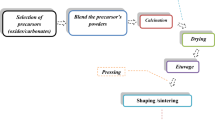Abstract
Tunable dielectric characteristics of 0.9Pb(Fe1/2Nb1/2)O3/0.1CaTiO3 relaxor ferroelectric ceramics were investigated as the function of DC bias field and temperature. High tunability (more than 20%) was obtained in the present ceramics under a relatively weak DC bias field (1.4 kV/cm). The value of tunability changed from negative to positive with increasing DC field. For the simulation of the dielectric constant under DC bias field, modified model needs to be constructed for the relaxor ferroelectrics. The dielectric constant curve as a function of temperature without and under DC field was well fitted using the equation of diffuse phase transition. The lower εmax, higher Tmax and higher diffuseness parameter under DC field were observed and only the lower εmax contributed to positive tunability.
Similar content being viewed by others
References
A.K. Tagantsev, V.O. Sherman, K.F. Astafiev, J. Venkatesh, and N. Setter, J. Electroceram., 11, 5 (2003).
X.X. Xi, H.C. Li, W. Si, A.A. Sirenko, I.A. Akimov, J.R. Fox, A.M. Clark, and J.H. Hao, J. Electroceram., 4, 393 (2000).
I.W. Chen, P. Li, and Y. Wang, J. Phys. Chem. Solids, 57(10), 1525 (1996).
L.E. Cross, Ferroelectrics, 76, 241 (1987).
S. Ananta and N.W. Thomas, J. Eur. Ceram. Soc., 19, 1873 (1999).
X. Hu, X.M. Chen, and S.Y. Wu, J. Eur. Ceram. Soc., 23(11), 1919 (2003).
X.F. Liang, W.B. Wu, and Z.Y. Meng, Mater. Sci. Eng., B 99, 366 (2003).
K.T. Kim, and C.I. Kim, Thin Solid Films, 420–421, 544 (2002).
F. Zimmermann, M. Voigts, W. Menesklou, and E. Ivers-Tiffée, J. Eur. Ceram. Soc., 24, 1729 (2004).
K. Johnson, J. Appl. Phys., 33, 2826 (1961).
K. Sakata, and Y. Masuda, Ferroelectrics, 7, 347 (1974)
J. Sigman, D.P. Norton, H.M. Christen, P.H. Fleming, and L.A. Boatner, Phys. Rev. Lett. 88(9), art. No. 097601 (2002).
S.G. Lu, Z.K. Xu, and H.D. Chen, Appl. Phys. Lett., 82(22), 5319 (2004).
R.C. Smith, and C.L. Hom, J. Intel. Mat. Syst. Str., 10(3), 195 (1999).
D.C. Jiles and D. L. Atherton, J. Magn. Magn. Mater., 61, 48 (1986).
O.G. Vendik and S.P. Zubko, J. Appl. Phys., 82(9), 4475 (1997).
O.G. Vendik and S.P. Zubko, J. Appl. Phys., 88(9), 5343 (2000).
I.A. Santos and J.A. Eiras, J. Phy.: Condens. Matter., 13, 11733 (2001).
Author information
Authors and Affiliations
Rights and permissions
About this article
Cite this article
Hu, X., Chen, X.M. & Wang, T. Tunable Dielectric Characteristics of 0.9Pb(Fe1/2Nb1/2)O3/0.1CaTiO3. J Electroceram 15, 223–227 (2005). https://doi.org/10.1007/s10832-005-3300-1
Received:
Revised:
Accepted:
Issue Date:
DOI: https://doi.org/10.1007/s10832-005-3300-1




